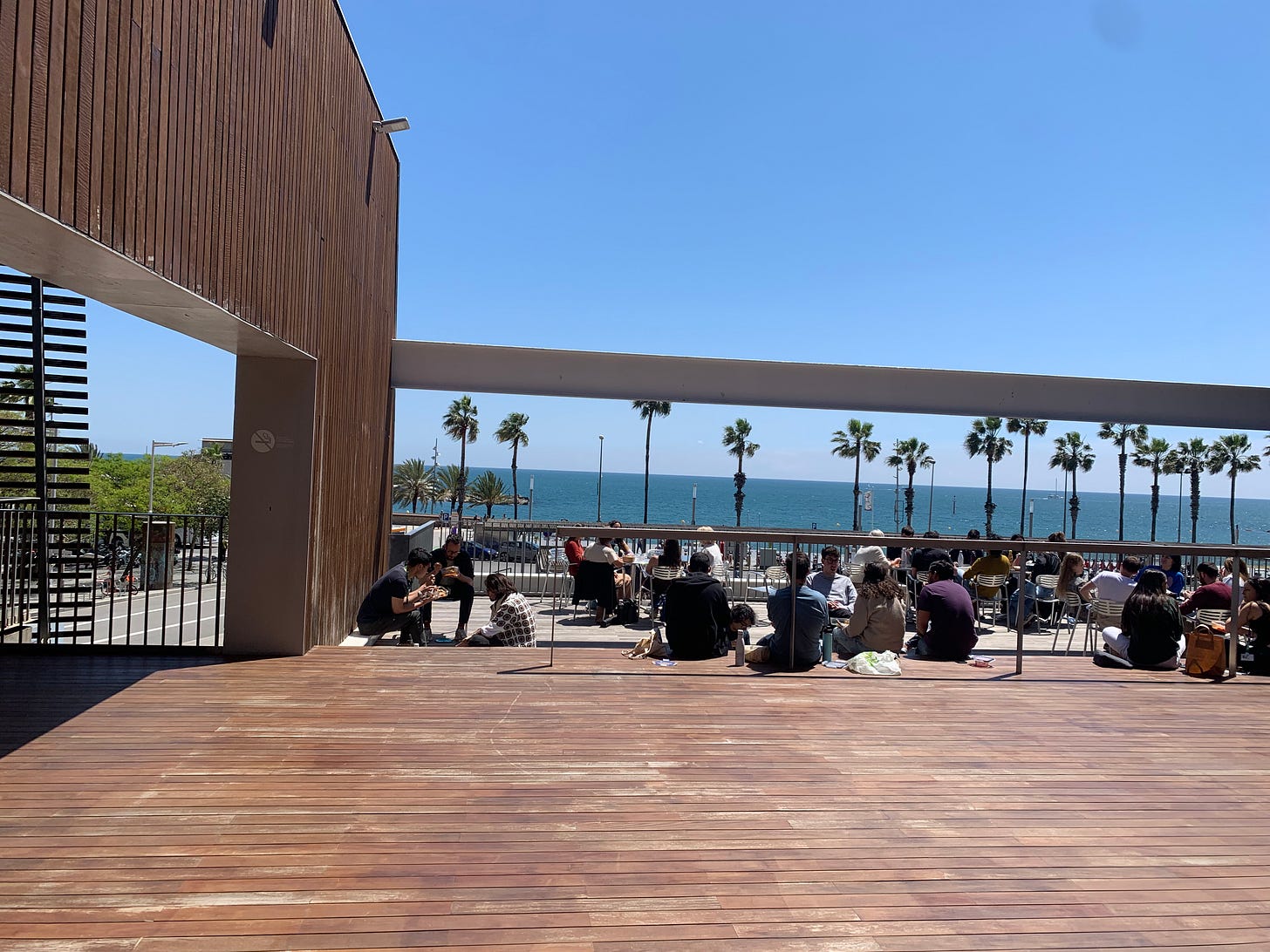Reporting live from Parental Brain 2025
The newest research on parenthood and the brain, part 1
The Hospital del Mar is a spiky, fortress-like building perched between a semi-industrial neighborhood and the Barcelona beachfront. Make your way through the gates of this villain’s lair and up to the second floor and there’s a stripe of pure blue ocean as a reward. I’m here for the Parental Brain conference to catch up on my tapas consumption and hear the latest research on the parental brain.
I’m going to try to write about some of the most interesting talks here because frankly, this research is really cool. And learning about how parenthood changes the brain is an important part of the larger societal conversation about how to support families and encourage births.
The first keynote speaker is one of the meeting’s hosts and organizers: Susana Carmona, who has done groundbreaking research on the maternal brain. She and her collaborator Elseline Hoekzema published a landmark 2017 paper finding that women lose brain volume across the transition to motherhood, in ways that are so striking that a machine learning algorithm can tell non-mothers apart from mothers. Although a smaller brain sounds bad, Carmona and her collaborators have linked this brain volume reduction to better mother-child bonding, suggesting that a shrunken brain may work more efficiently to process social information from the infant. Moreover, brain volume loss did not impair cognitive performance in their sample of women. Indeed, the areas that lost the most volume are in regions implicated in social cognition and empathy, which are important in infant care.
Carmona’s conference talk is a master class in how to describe a program of research. She starts with the original findings and then describes an elegant series of studies that branch out from them, interrogating questions that deepen our understanding of the maternal brain. These include:
Are the brain changes similar to those taking place during adolescence?
Yes! Carmona and her team pursued this work because early media coverage of her maternal brain findings used an implicit deficit model, referring to brain “atrophy.” She wanted a more developmental frame instead, one that might reflect normative adaptation to a life stage. She contrasted her sample of mothers with a sample of adolescents followed across puberty, finding very similar magnitudes of brain volume change.
Do these brain changes reverse?
It seems like they persist instead. There is evidence that smaller brain volume persists in mothers followed two years after birth, compared to a comparison sample of non-mothers. Carmona’s team has even found smaller brain volumes six years after birth, although the latter study had a very small sample given that many moms in her sample had more than one child and many of the non-mothers had become mothers by the six-year follow-up.
Do fathers undergo similar brain changes?
Yes- similar, but not exactly the same. I’ll write about the dad brain symposium in a separate post, but briefly, we combined data from Spanish dads drawn from Susana’s study (the partners of mothers in her sample) and the dads we scanned at my lab. Both samples were comprised of first-time fathers followed from before to after birth. We found similar brain changes as the mothers, but they were less striking and significant overall.
What is the temporal course of the brain changes?
This gets really interesting. Susana’s group has published some elegant recent work suggesting that the trajectory of brain change across the transition to first-time motherhood is not linear, but rather U-shaped. Take a look at the graph above, and you’ll see that brain volume dips right before birth in mothers (the orange line) but not in non-mothers (green line) or the female partners of the gestational mothers (“non-gestational mothers”; blue line). The structures then recover in size in the first six months after birth, such that the mothers regain some brain volume but still have slightly smaller brains at postpartum than before pregnancy.
The U-shaped pattern that Carmona’s group uncovered is uncannily similar to the results of an intensive longitudinal neuroimaging study in which a single, heroic mother underwent 26 MRI scans, starting three weeks before pregnancy and finishing two years after birth. As you can see from the figure below, her grey matter volume, cortical thickness, and overall brain volume all dipped around birth and then slowly rebounded.
Are these changes mediated by gestational hormones?
Yes! In the same paper that reported on the U-shaped trajectory of maternal brain volume, the authors also linked that trajectory to changes in estrogen across pregnancy, with estrogen rising as brain volume decreases in a mirror image. The figure below shows decreasing brain volume (orange line) and increases in two sulfated estrogens. (They also tested some other androgen and estrogen hormones that did not track with brain change).
Do brain changes related to postpartum depressive symptoms?
Yes! One study found that when the amygdala increased in volume from prenatal to postpartum, women reported more postpartum depression. There’s a lot more to say about perinatal depression and the brain, so I’ll save that for a separate post.
I’ll write about the fatherhood research next!








What a wonderful location for a conference!